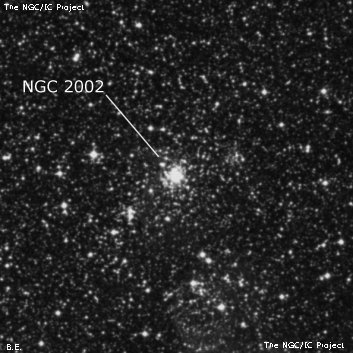
NGC 2002 is at the west end of a huge, arcing string of associations (bowed to the south) referred to as LH 77 or the "Quadrant", which extends nearly 40' to the east beyond NGC 2041. The Quadrant, itself, defines the southern rim of the huge LMC-4 Superbubble, a ring of HII regions and clusters spanning 6000 l.y.
James Dunlop discovered NGC 2002 = D 214 on 24 Sep 1826 and recorded a "a round small nebula, 12" or 15" diameter." He made two observations and his position is 4.7' SW of the cluster. JH credited Dunlop with the discovery.
JH made two observations for h2890. On 20 Dec 1835 he logged "place of a double star, the chief of a great cluster of small stars loose and filling the field. It is the forerunner of the great cluster-region [OB association LH 77] of the nubecula." On a second sweep he called it "vB, S, R. Here comes on the richest and brightest part of the starry and clustering portion of the nubecula. (Note - From this object being described at one time as a double star, and at another as a nebula, it is probable that it is one of those singular close-knotted groups which especially characterize the nubeculae)." So, it appears he is describing two objects -- one the cluster (containing the double star) and second, the association that contains the cluster.
600/800mm - 24" (4/7/08 - Magellan Observatory, Australia): at 200x this cluster is extremely bright but small. It is sharply concentrated with a small, brilliant core surrounded by a much fainter 30" halo. At 346x, the core diameter is ~15" diameter and three interior stars are resolved, the brightest on the southeast side. Sharing the same field 8' SE is the double cluster NGC 2006 and S-L 538.
Notes by Steve Gottlieb